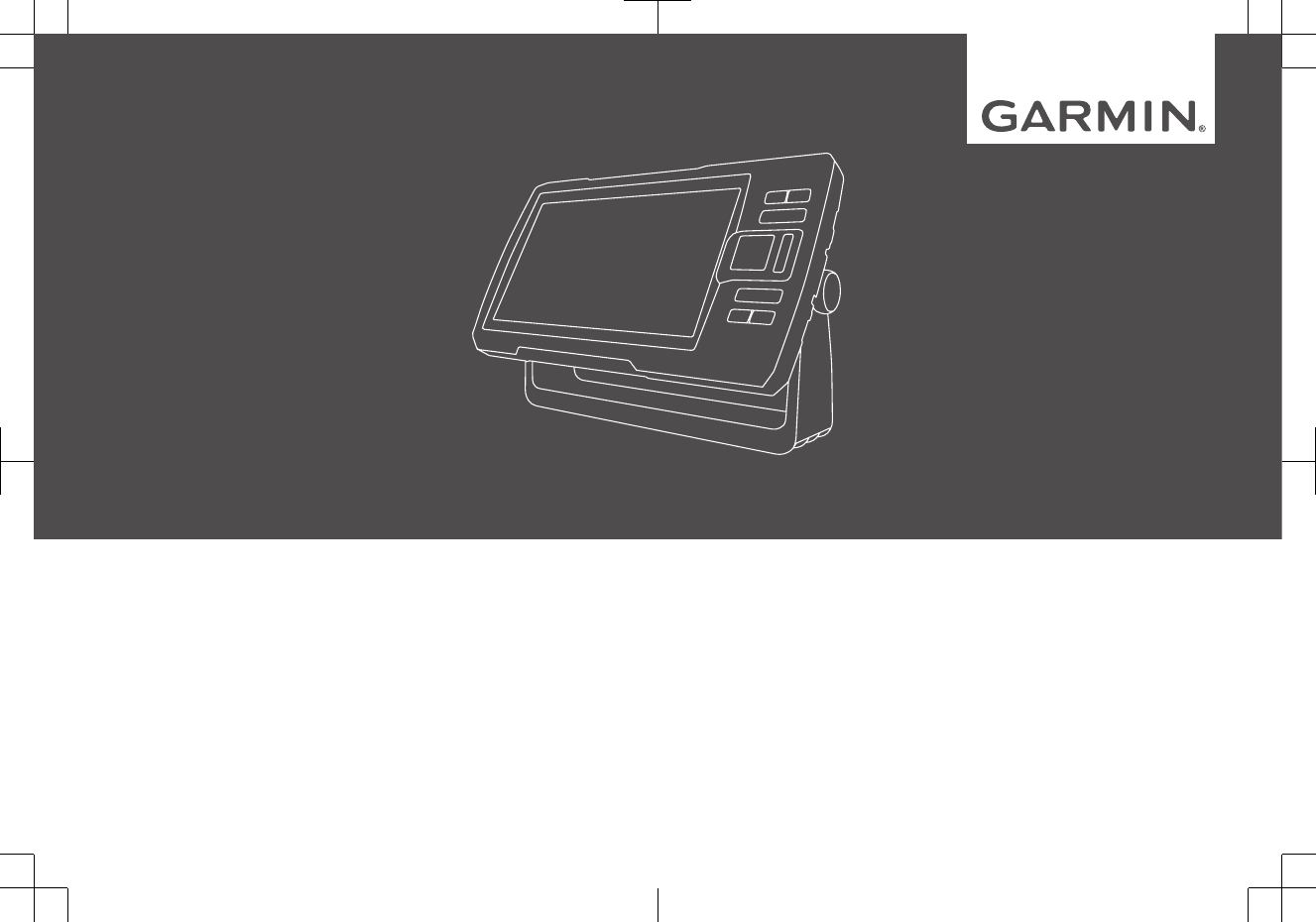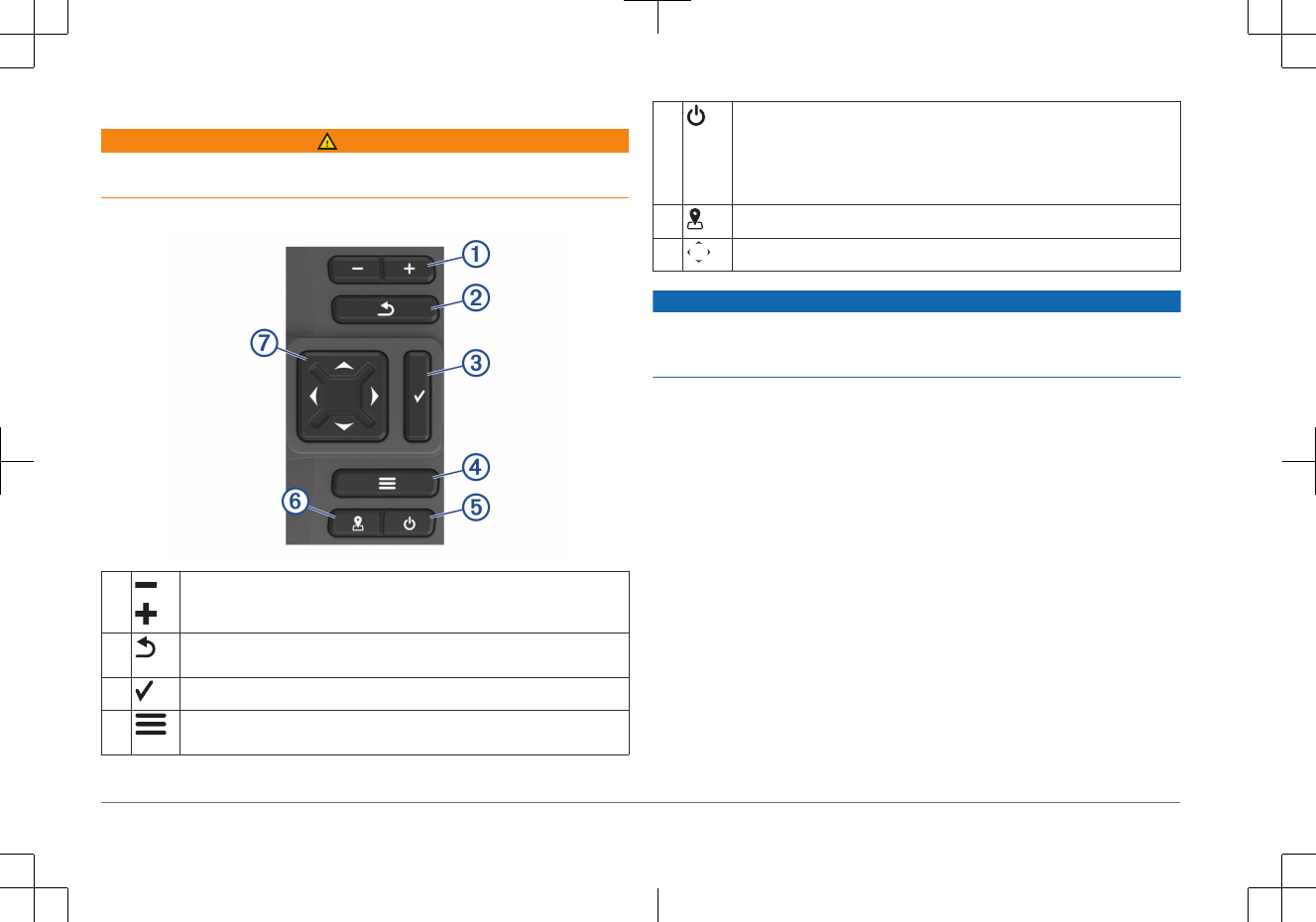Garmin 03294 Digital Transmission System 2412-2462 MHz User Manual
Garmin International Inc Digital Transmission System 2412-2462 MHz
Garmin >
Contents
- 1. User Manual
- 2. User Manual 1
User Manual

STRIKER™ PLUS 7/9
Quick Start Manual

Introduction
WARNING
See the Important Safety and Product Information guide in the product box for
product warnings and other important information.
Device Keys
ÀZooms out of a view.
Zooms in to a view.
ÁReturns to the previous screen.
Returns to the home screen when held.
ÂAcknowledges messages and selects options.
ÃCloses a menu, when applicable.
Opens a menu of options for the page, when applicable.
ÄTurns on and off the device when held.
Performs one or more of these actions when quickly pressed:
• Adjusts the backlight
• Adjusts the color mode
• Enables and disables sonar
ÅSaves the present location as a waypoint.
ÆScrolls, highlights options, and moves the cursor.
NOTICE
Before turning on the device, you must firmly press the connectors into the
appropriate holes in the device. If the cables are not pressed far enough into the
device, the device appears to lose power or stop working.
Getting the Owner's Manual
Go to www.garmin.com/manuals/STRIKERPlus7-9.
Getting Started with the ActiveCaptain™ App
NOTE: The ActiveCaptain feature is only available on models that have Wi‑Fi®
technology.
You can connect a mobile device to the STRIKER Plus device using the
ActiveCaptain app. The app provides a quick and easy way for you to interact
with your chartplotter and complete such tasks as sharing data, registering, and
updating the device software and maps.
1From the STRIKER Plus device, select ActiveCaptain.
2From the ActiveCaptain page, select Wi-Fi Network > Wi-Fi > On.
3Enter a name and password for this network.
4From the application store on your mobile device, install and open the
ActiveCaptain app.
5Bring the mobile device within 24 m (80 ft.) of the STRIKER Plus device.
2Quick Start Manual

6From your mobile device settings, open the Wi-Fi connections page and
connect to the Garmin® device, using the name and password you entered in
the Garmin device.
For more information about the ActiveCaptain app and features, see the Owner's
Manual at www.garmin.com/manuals/STRIKERPlus7-9 or watch a video at
www.garmin.com/ActiveCaptainVideo.
Acquiring GPS Satellite Signals
The device may need a clear view of the sky to acquire satellite signals. The time
and date are set automatically based on the GPS position.
1Turn on the device.
2Wait while the device locates satellites.
It may take 30 to 60 seconds to acquire satellite signals.
When the device acquires satellite signals, appears at the top of the Home
screen.
If the device loses satellite signals, disappears and a flashing question mark
appears over on the chart.
For more information about GPS, go to www.garmin.com/aboutgps.
Adjusting the Backlight
1Select Settings > System > Display > Backlight.
2Adjust the backlight.
TIP: From any screen, press repeatedly to scroll through the brightness
levels. This can be helpful when the brightness is so low you cannot see the
screen.
Adjusting the Color Mode
1Select Settings > System > Display > Color Mode.
TIP: Select > Color Mode from any screen to access the color settings.
2Select an option.
Customizing the Home Screen
You can add items to and rearrange items on the Home screen.
1From the Home screen, select Customize.
2Select an option:
• To rearrange an item, select Rearrange, select the item to move, and
select the new location.
• To add an item to the Home screen, select Add, and select the new item.
• To remove an item you have added to the Home screen, select Remove,
and select the item.
Sonar Fishfinder
When properly connected to a compatible transducer, your STRIKER Plus device
can be used as a fishfinder.
For more information about which transducer is best for your needs, go to
www.garmin.com/transducers.
Different sonar views can help you view the fish in the area. The sonar views
available vary depending on the type of transducer and sounder module
connected to the chartplotter. For example, you can view Garmin ClearVü™ sonar
screens only if you have a compatible Garmin ClearVü transducer connected.
There are four basic styles of sonar views available: a full-screen view, a split-
screen view that combines two or more views, a split-zoom view, and a split-
frequency view that displays two different frequencies. You can customize the
settings for each view in the screen. For example, if you are viewing the split-
frequency view, you can separately adjust the gain for each frequency.
If you do not see an arrangement of sonar views to suit your needs, you can
create a custom combination screen.
Traditional Sonar View
There are several full-screen views available, depending on the transducer that is
connected.
Quick Start Manual 3

The full-screen Traditional sonar view shows a large image of the sonar readings
from a transducer. The range scale along the right side of the screen shows the
depth of detected objects as the screen scrolls from the right to the left.
ÀDepth information
ÁSuspended targets or fish
ÂBottom of the body of water
Selecting the Transducer Type
If you are connecting a transducer that was not included with the device, you may
need to set the transducer type to make the sonar function properly. Before
connecting the transducer, you should select the transducer type. The transducer
name should be listed on the label on the transducer cable, near the connector.
This device is compatible with a range of accessory transducers, including
Garmin ClearVü transducers, which are available at www.garmin.com
/transducers.
1Select Settings > My Vessel > Transducer Type.
2Select an option:
• If you have a 200/77 kHz, dual-beam transducer, select Dual Beam
(200/77 kHz).
• If you have a 200/50 kHz, dual-frequency transducer, select Dual
Frequency (200/50 kHz).
• If you have another type of transducer, select it from the list.
Sonar Frequencies
NOTE: The frequencies that are available depend on the transducer being used.
Adjusting the frequency helps adapt the sonar for your particular goals and the
present depth of the water.
Selecting Frequencies
NOTE: You cannot adjust the frequency for all sonar views and transducers.
You can indicate which frequencies appear on the sonar screen.
1From a sonar view, select > Frequency.
2Select a frequency suited to your needs and water depth.
Creating a Waypoint on the Sonar Screen Using the Device Keys
1From a sonar view, use the arrow keys to select a location to save.
2Select .
3If necessary, edit the waypoint information.
Navigation
Marking Your Present Location as a Waypoint
From any screen, select .
Navigating to a Waypoint
1From the Quickdraw Map, use the arrow keys to select the waypoint.
The waypoint name appears on the screen.
2Select .
3Select Navigate To > Go To.
Creating and Navigating a Route Using the Map
The starting point can be your present location or another location on the map.
1Select User Data > Routes > New > Route Using Chart.
2Pan the map to select the starting location of the route.
4Quick Start Manual

3Select to add a turn to the route.
4Repeat to add all of the turns in the route.
5Select > Navigate To.
6Select an option.
Marking and Navigating to a Man Overboard Location
From any screen, select > Man Overboard > Yes.
The fishfinder sets a direct course back to the location.
Mapping a Body of Water Using the Garmin Quickdraw™
Contours Feature
Before you can use the Garmin Quickdraw Contours feature, you must have
sonar depth and your GPS position.
1Select Quickdraw Map > > Quickdraw Contours > Start Recording.
2When recording is complete, select > Quickdraw Contours > Stop
Recording.
Troubleshooting
My device does not turn on
• Push the power cable all the way into the back of the device.
Even if the cable seems to be connected, you should push firmly so that it is
fully seated.
• Make sure the power source is generating power.
You can check this several ways. For example, you can check whether other
devices powered by the source are functioning.
• Check the fuse in the power cable.
The fuse should be located in a holder that is part of the red wire of the power
cable. Check that the proper size fuse is installed. Refer to the label on the
cable or the installation instructions for the exact fuse size needed. Check the
fuse to make sure there is still a connection inside of the fuse. You can test
the fuse using a multimeter. If the fuse is good, the multimeter reads 0 ohm.
• Check to make sure the device is receiving at least 10 Vdc, but 12 Vdc is
recommended.
To check the voltage, measure the female power and ground sockets of the
power cable for DC voltage. If the voltage is less than 10 Vdc, the device will
not turn on.
My sonar does not work
• Push the transducer cable all the way into the back of the device.
Even if the cable seems to be connected, you should push firmly so that it is
fully seated.
• Press , and ensure sonar is enabled.
• Select the correct transducer type (page 4).
Garmin Support Center
Go to support.garmin.com for help and information, such as product manuals,
frequently asked questions, videos, software updates, and customer support.
Quick Start Manual 5



support.garmin.com
© 2017 Garmin Ltd. or its subsidiaries
Garmin®, the Garmin logo, and Ultrascroll® are trademarks of Garmin Ltd. or its subsidiaries, registered in the USA and other countries. ActiveCaptain™, Garmin ClearVü™, Garmin Quickdraw™,
and STRIKER™ are trademarks of Garmin Ltd. or its subsidiaries. These trademarks may not be used without the express permission of Garmin.
Wi‑Fi® is a registered mark of Wi-Fi Alliance Corporation.
Printed in Taiwan
September 2017
190-02226-02_0A